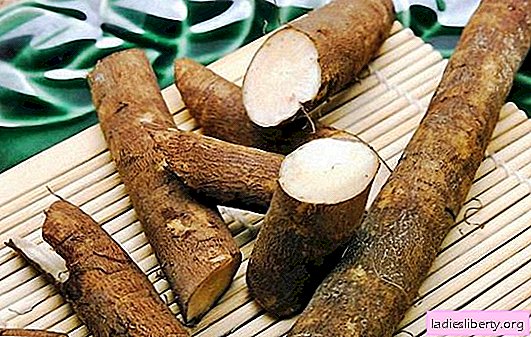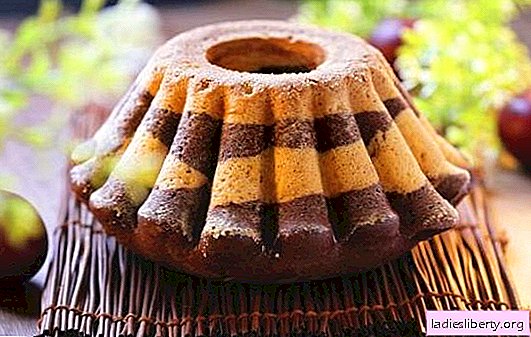
It so happened that vinaigrette around the world is considered the traditional "Russian salad".
The reason for this, which has already become widely known, is a curious case.
A French cook who served in the court of the Russian emperor uttered the words “vinaigrette” when he saw a Russian chef dressing salad with vinegar.
The Russian chef thought it was the name for cooked salad in France; he liked this word and since then they began to call Russian classical vinaigrette “vinegar”, though in French.
At all, multi-component salads appeared in Russian cuisine due to the influence of the French, which have been brought to Russia since the time of Great Peter to instill European manners in Russian boyars. In Russian cuisine, salads consisted, as a rule, of one ingredient, and vinegar in Russia was known from the beginning of the Byzantine period, from the adoption of Christianity. Another interesting fact: the chopped vegetables, meat and fish marinated with vinegar were taken by mariners on trips, often combining products in one barrel, and pre-Petrine Rus practically had no access to the sea. Maybe then, thanks to the first sea voyages, a vinaigrette appeared? True, sauerkraut, which our ancestors learned to cook back in pre-Christian times, is still a purely Russian component of vinaigrette, because in such a combination salad with vinegar dressing is still cooked only in Russia.
As for European cuisine, the word "vinaigrette" in it means salad dressing, which includes vinegar. There are an incredible variety of salad dressing recipes, which makes the assortment of salads even more diverse.
Vinaigrette with potatoes - basic technological principles
A short digression into history suggests the idea that the composition of the vinaigrette may include not only vegetables, but also fruits, meat, fish. That is, in fact, vinaigrette is a multi-component salad with dressing, which includes vinegar.
Perhaps the most distinctive feature of vinaigrettes is one single component - beet. It is used in boiled and baked form in almost all types of vinaigrettes. It should be noted that of all the root crops, preference should be given to table varieties with an intense burgundy color of the fruit, such as Bordeaux, which are distinguished by increased taste, have a sweet taste and soft texture, without a pronounced rigid, fibrous structure. Often, housewives in the preparation of vinaigrettes encounter a problem regarding the use of this vegetable as a part of salad: beets color all other components of the dish in a burgundy color, which makes it difficult to create a beautiful, colorful composition of vegetables. To avoid staining beets and other components of vinaigrette, boil it in salted and acidified water. After cutting it into cubes, pre-fold it in a separate bowl, grease it with vegetable oil, mix: “sealing” with oil will help preserve the natural color of the rest of the products.
If the beets are not sweet enough, which will certainly affect the taste of the dish, where the combination of all the flavoring shades has an important role, then depending on the stage at which the flaw is found, the situation can be corrected in the following ways:
Add sugar to the water during the cooking of beets;
You can sweeten the root crop when the beets are already diced: caramelize it, sprinkle it slightly with sugar and hold in a hot oven until it dissolves;
You can also bring the taste of vinaigrette by adding sugar along with salt, mustard and other spices to the dressing.
Vegetables for vinaigrettes, as a rule, are boiled “in their uniforms”, but in the home kitchen, unlike catering establishments, you can bake them in the oven by wrapping with foil to preserve the maximum amount of useful properties in the products. In addition, baked potatoes, beets and carrots have a more interesting taste, which will be transmitted to vinaigrette.
The ratio of all ingredients in the salad should be balanced so that products with a lower moisture content do not prevail over ingredients with a higher degree of humidity, and vice versa. Therefore, traditionally, in complex, multicomponent salads and vinaigrettes, the same number of products is used in terms of mass, taking into account their density and humidity.
As for slicing ingredients for vinaigrettes, it is not necessary to always cut them into cubes. Sometimes cut food into slices. For the preparation of puff salads, for example, herring under a "fur coat", where potatoes, beets and carrots are used, as for all types of vinaigrettes, they are not cut, they are ground with a grater and laid on the dish alternately, in layers, seasoning with mayonnaise. By the way, mayonnaise is a sauce, which also includes vinegar.
Recipe 1. Vinaigrette with potatoes, sauerkraut and white beans - a classic version
Ingredients (same amount, by net weight):
Sauerkraut
Boiled Beans
Salted cucumbers
Boiled carrots
Beet
Potatoes
Pickled Onions
For refueling (to taste):
Salt
Mustard
Sugar
Vinegar
Natural sunflower oil
Cooking:
The whole process of preparing and slicing potatoes, beets and carrots is described above. We cut all the vegetables of the same size. Cut the peeled onions into thin strips or half rings and keep in water combined with an equal amount of vinegar or lemon juice to remove bitterness. If the beans are canned, then drain the marinade and rinse it under running water. Let the water drain. It is desirable that the beans are not large, and so that they do not stand out in size against the background of other components. Hold the chopped pickles before laying in the dish in a colander to remove excess brine, otherwise the vinaigrette will turn out to be too watery or even salty. Also do with sauerkraut.
It is advisable not to mix any salads too intensively and often, but in the case of vinaigrette it will have to be done twice, given that the products being laid have a sour or salty taste, each individually, because you need to determine how much sugar, salt and vinegar can be used in the dressing . Try the vinaigrette without dressing and add the missing ingredients to bring it to taste. Dressing can be prepared separately and poured with it vinaigrette for half an hour before use, or add the necessary ingredients separately.
Recipe 2. Vinaigrette with potatoes and green peas and fresh white cabbage
Ingredients (150 g each, net weight):
Yield: 5-6 servings
Baked potato peeled
Carrot
Beet
Fresh white cabbage
Canned green peas
Pickles
Green onions
Lemon Juice 150 ml
Sugar
Salt
Unrefined oil
Cooking:
Replacing vinegar with lemon juice, you can get a new taste of the usual vinaigrette. Before squeezing the juice from the lemon, remove the zest from it: it can also be added to the vinaigrette. If you don’t like this option, then the zest is useful for other dishes. To squeeze more juice, hold the lemon for a few seconds in boiling water.
Finely chop fresh cabbage, sprinkle it with lemon juice, salt, sprinkle with sugar and slightly knead to release the juice. Let stand for at least an hour. Chop green onions finely and also soak in lemon juice. After peeling the remaining vegetables, cut them into cubes the size of a pea. Combine all ingredients and season.
Recipe 3. Vinaigrette with potatoes, pickled herring and quail eggs with mayonnaise
Ingredients:
Jacketed potato 450 g
Onion, small (bulb) 300 g
Quail eggs 12 pcs.
Baked beets 250 g
Fresh cucumbers 200 g
Carrots marinated 150 g
Herring fillet 800 g
Vinegar
Salt
Allspice
Clove
Sugar
Mayonnaise
Sprigs of parsley and dill (for decoration)
Cooking:
The main components of this vinaigrette are potatoes, herring and eggs.
Cut the herring fillet into thin slices, holding the knife at an angle of 45 °, so that the pieces are wide enough and can be rolled up. Put the herring in a separate plate and soak in a marinade of vinegar, combined with water in a ratio of 1: 1, crushed allspice and mashed buds of cloves. If the herring is lean, add some vegetable oil to the marinade. Pickling time - at least 3 hours.
Choose potatoes of the same size, round shape, wash and boil them in a peel. After cooling slightly, remove the peel and cut into thin slices, approximately the same size as the herring slices.
Chop small onions into thin rings and pickle in vinegar or lemon juice, adding salt and sugar.
We do the same with fresh, peeled and washed carrots: chop thin round plates and place in the marinade. Choose large root vegetables for the salad to get rings 2-3 cm in diameter. Use the remaining parts of the peeled carrots to prepare other dishes. For the convenience of cooking, put the carrots in the marinade, separately from the onion.
Cut the beets into thin plates and squeeze “flowers” from each plate using curly notches for cookies. Stack the finished pieces of beets on a plate and "seal" with vegetable oil.
We prepare the boiled and peeled quail eggs as follows: we cut off part of the protein from the narrower side of the egg to give it stability. On the opposite side, remove the protein, making a zigzag knife to get the shape of a lily.
Fresh cucumbers are cut into thin oblong plates so that they can be bent in half. In the center of each plate of the cucumber we make incisions at a distance of 0.5 cm, not reaching the edge, so that when bent, half rings are obtained.
Wash leaves of dill and parsley, remove the water. We begin to form a holiday vinaigrette on a flat and wide dish. For ease of laying out, use skewers:
5 round slices of potato in the form of a flower, overlap lay on a dish.
Between the potatoes, put the "flowers" carved from beets.
Raising the edges of the "flowers" of potatoes and beets, place bent slices of fresh cucumbers beneath them - if necessary, use skewers to fix the composition, and lay greens on skewers.
Set eggs on beetroot “flowers”. Roll up herring slices, wrapping each of them in 5 carrot “petals” and fixing the resulting “flower” with a skewer. Place it on the potato slices.
Disassemble the onion slices into rings and set them perpendicularly throughout the dish, between the fragments of the composition.
Recipe 4. Vinaigrette with potatoes, eggs, celery and pickled mushrooms
Ingredients:
Baked potatoes 200 g
Eggs, boiled 4 pcs.
Baked Beets 150 g
Chives 100 g
Lemon juice 50 ml
Pickled champignons 300 g
Prunes 70-75 g
Gouda cheese
Garlic 15 g
Chopped walnuts (for dressing)
Mayonnaise
Oranges 400 g
Greens (for decoration)
Cooking:
For the salad, choose champignons of the same small size. Finely chop the onion and soak it in a solution of lemon juice and water; Squeeze gently to remove excess fluid. Prune with boiling water and chop finely when it swells and cools. Add a slice of chopped garlic and 50-60 g chopped nuts. Combine this mixture with grated boiled beets; mix. Peel oranges from a peel and a membrane; break the slices in half. Grate all other ingredients on a coarse vegetable grater.
Lay the salad in layers in the following order: potatoes, seasoned boiled beets, eggs, cheese, oranges, green onions. Lay the mushrooms on top, with their heads up. Pour each layer with mayonnaise.
Recipe 5. Vinaigrette with potatoes, duck, apples and celery
Ingredients:
Smoked duck breast 400 g
Jacketed potato 200 g
Pickled beets 250 g
Boiled carrots 150 g
Boiled celery (root) 100 g
Apples, sweet and sour 300 g
Refueling:
Table vinegar 20 ml
Tangerine juice 50 ml
Mustard oil 40 ml
Salt
Honey 30 g
Ground pepper
Rosemary, fresh
Cooking:
Begin cooking vinaigrette with dressing: it should be infused for at least an hour.
Prepare the rest of the ingredients. Apples need to choose a sour-sweet variety with dense pulp. Peel the duck breast. Duck meat can be replaced with smoked beef or dried sausage. Cut all the components of the salad into equal cubes and combine in a salad bowl. Pour in the dressing, mix and let it brew. For decoration, use the ingredient included in the dish.
Recipe 6. Vinaigrette with potatoes and salted salmon
Ingredients:
Boiled beets 150 g
Salmon Fillet 350 g
Boiled potatoes 250 g
Pickled onions 120 g
5 eggs
Black olives 200 g
Boiled carrots 100 g
For refueling:
Olive oil 80 ml
Salt
Ground pepper
Balsamic vinegar 40 ml
Sugar
Cooking:
Dice all the ingredients except eggs and olives. Cut the olives across the rings. Mash boiled yolks with butter, salt and pepper. Add vinegar and sugar. Cut the squirrels finely and add to the salad.
Recipe 7. Vinaigrette with potatoes, seaweed and squid
Ingredients:
Boiled eggs 4 pcs.
Squid fillet, boiled 300 g
Pickled onions 100 g
Boiled potatoes 250 g
Sea kale 200 g
Boiled beets 150 g
Refueling: balsamic vinegar, refined oil, sugar, salt
Cooking:
Cut beets, boiled squid carcass and potatoes into thin strips. Add the oil to the chopped beets and mix well. Chop the onion in half rings and soak it in cold, boiled water, acidified with vinegar. Add sugar and salt. Separate the yolks from the eggs and grind them with vegetable oil, add balsamic vinegar. Combine all components, season and, after mixing, let stand for 30-40 minutes before serving.
Vinaigrette with potatoes - useful tips and tricks
So that vegetables for vinaigrette are quickly and simultaneously boiled or baked, sort them before cooking by size. In this case, it is advisable to choose beets small.
All salads have a short shelf life, especially after adding dressings to them, so always try to cook them in the amount necessary for one meal.
Boiled or baked vegetables for vinaigrette can be stored whole for up to 24 hours, in a closed container in the refrigerator, pouring a little salt into it at the bottom. This method of preparation and storage makes it possible to divide the cooking into two stages and to better distribute the time: before consuming the vinaigrette, you can always get the vegetables boiled in advance from the refrigerator and immediately start slicing them, which will not take much time, especially if there are appropriate salad slices kitchen appliances.
For salads, you need to choose potatoes with a higher starch content so that when sliced it does not crumble. If during cooking it turned out that only a variety of friable tubers is available, very suitable for making mashed potatoes, and there is no time left for going for potatoes, cook what is, but add a couple of tablespoons of vinegar to the water so that the potatoes do not crumbled. Potatoes need to be salted only before the end of cooking.











